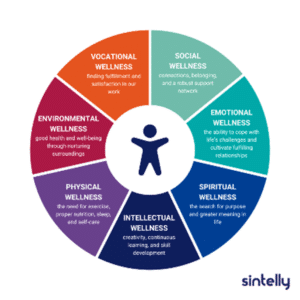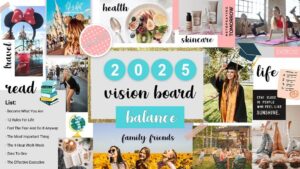Creating a Vision Board For Your Dreams in Retirement

Retirement can be a time to embrace new beginnings, explore passions, and live life to the fullest. For seniors and baby boomers, creating a vision board can be a powerful tool to visualize and manifest their dreams during the retirement years.
In this blog post, we’ll explore the history of vision boards, why they’ve become popular, and provide detailed steps to craft one for yourself. Plus, we’ll share tips on how to display and revisit your vision board to keep your dreams alive.
The History of Vision Boards
The concept of vision boards has roots in the practice of visualization, which has been used for centuries by athletes, performers, and successful individuals to achieve their goals. The modern vision board, as we know it today, gained popularity in the early 2000s with the release of the book “The Secret” by Rhonda Byrne. Her self-help book became #1 on New York Times bestseller list and was followed up by “The Power”.
The book emphasizes the power of the law of attraction and how visualizing one’s desires can help manifest them into reality. Since then, vision boards have become a popular tool for individuals of all ages to focus on their goals and aspirations. Crafting one can help aging adults to set intentions and aim for the important things they want to achieve.
Why Vision Boards Have Become Popular
Vision boards have gained popularity for several reasons:
Clarity and Focus: They help individuals clarify their goals and maintain focus on what truly matters to them. It is easy to get pulled in many directions in our busy lives. But this is a chance to give pause and prioritize what we are seeking to manifest for ourselves.
Motivation: Seeing visual representations of their dreams can inspire and motivate older adults to take action. Anything worth having in life usually takes some effort and work to achieve it. The vision board technique may pull in elements of the goal and the path to reach it.
Positive Thinking: Vision boards encourage positive thinking and a hopeful outlook on the future. Developing your own vision board can include mindful moments where you reflect on what you are grateful for and what you want to build on for now and into the future.
Creativity: The process of creating a vision board is a fun and creative activity that allows individuals to express themselves. Truly, the creation of a vision board should allow aging adults to move beyond self-imposed confines or narrow limitations. Just let the energy flow –
Steps to Create Your Own Vision Board
It is important to start with an open mind and enjoy the process. There are no rules except to make it your own. So, what you create can be simple and more structured or a colorful and elaborate mishmash collage. You can finish it in one session or build it up over time as you are inspired.
Gather Supplies: You’ll need a poster board or larger sheet of paper, magazines or catalogs, scissors, glue and tape, markers, paint, or colored pencils, and any other decorative items you like (e.g., stickers, ribbons, fabric, charms, photos). You may also be inspired to use cut-outs from food packaging, junk mail or old greeting cards.
In addition, you can print images you want from secure online sources. Several possibilities for you to consider include Freepix, Pixabay, Creative Commons and/or Canva. On these websites, you’ll find a search function to track down specific images you want to include. Use your imagination as the choices are vast. And, in fact, you could create a digital vision board on Canva. If you are more comfortable with the computer than paper and glue, this could be a better option for you.
Set Your Intentions: Take some time to reflect on your dreams and goals for the future. If you are not yet retired, then this may be a theme.
 If you are already in retirement, then you may want to think through all the dimensions of holistic well-being. Consider aspects of these dimensions you want to maximize. Then match that to things you enjoy or have enjoyed in the past and want to return to. Would things like this be in the mix: physical or spiritual health, new or existing relationships, travel, hobbies, or other aspects of personal growth?
If you are already in retirement, then you may want to think through all the dimensions of holistic well-being. Consider aspects of these dimensions you want to maximize. Then match that to things you enjoy or have enjoyed in the past and want to return to. Would things like this be in the mix: physical or spiritual health, new or existing relationships, travel, hobbies, or other aspects of personal growth?
Collect Images and Words: Now that you have intentions as a focal point, you are ready to move along to the next step. Look through the magazines and catalogs and cut out images and words that resonate with your intentions. Print images from online resources or use personal photos. As you compile these things, you may find a specific color or colors are more prominent.
This makes sense because different colors can invoke different feelings. What is feeling like a fit for you? Is there a lot of green? That can mean new beginnings, abundance, nature, and growth. Or perhaps there is more blue? Blue brings a feeling of calm, peace, and stability.
Arrange and Attach: At this point, you can arrange the images and words on your board. Again, there is no right or wrong way. Put things together in a way that feels meaningful or pleasing to you. If you decide not to use the images or words you collected, that is absolutely fine. Once you’re satisfied with the layout, glue or tape everything in place.
Add Personal Touches: Use markers or colored pencils to write affirmations, quotes, or any other personal touches that inspire you. If you like to draw or paint, you can add those types of elements.
If you’d like, you can add dimension with ribbon, lace, charms or layers of paper. As you are personalizing your vision board, think about the intentions you set in the first step. You can even write out your intentions in detail if this helps you focus.
Display Your Vision Board: You have now created a vision board! Take a moment to reflect on the process and how your creativity came to life. Then you can place your vision board in a prominent location where you’ll see it daily, such as your bedroom, office, or living room. You can go as far as to frame it and hang it on the wall. Or if you prefer, you can prop it on the corner of your desk. The idea is to keep it out as a reminder of what you want to manifest in your life.
Feel free to share your vision board journey with friends and family, and encourage them to create their own.
Revisiting and Updating Your Vision Board
To keep your vision board relevant and inspiring, it’s useful to revisit and update it regularly:
Daily or Weekly Reflection: Spend a few minutes each day or, say, 10 minutes each week looking at your vision board and visualizing your dreams coming true.
Monthly Check-In: Take some time each month to review your vision board and make any necessary updates or adjustments. If you have taken actions that move you closer to your goal, add a post-it note to your vision board to capture that message.
Celebrate Achievements: When you achieve a goal or dream, celebrate your success and consider adding new aspirations to your vision board. And when you are ready, you can retire your vision board and create a new one for your new dreams and goals.
Creating a vision board for retirement is a wonderful way to stay focused on your dreams and make the most of your golden years. By visualizing your ideal retirement, you can turn your aspirations into reality and enjoy a fulfilling and joyful life. And by visualizing new things to do and pursue in the later years, you can benefit from continual learning and personal growth.
Additional Resources and Information
Here are some additional resources that you may find helpful. Check out the information from Silver Sneakers, AARP Senior Planet and Babyboomer.org. Remember, there is no right or wrong way to create your vision board. Enjoy the process!
Leave a Comment
